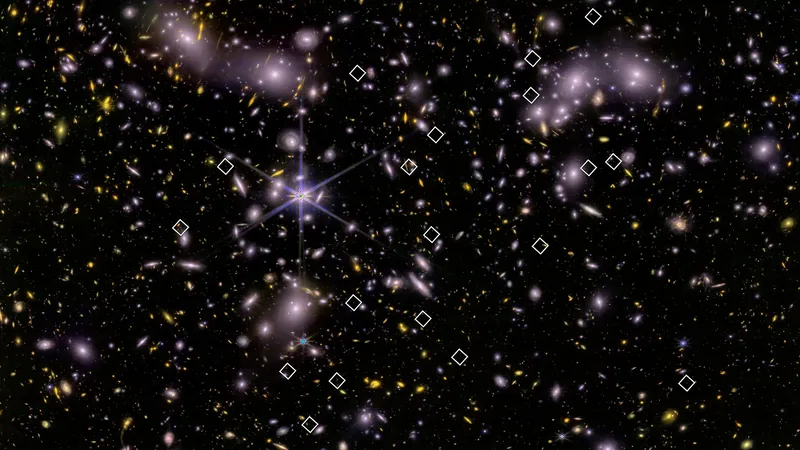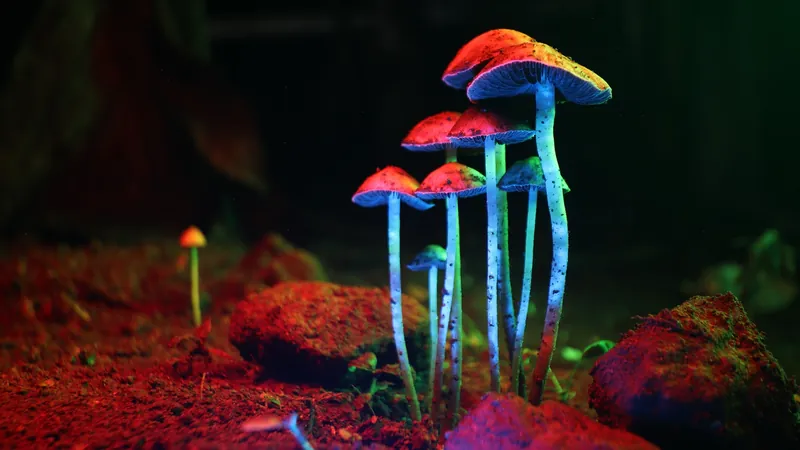
Stunning Discoveries: Webb Telescope Unveils Starburst Galaxies Igniting the Early Universe
2025-06-14
Author: Daniel
Galaxies That Defy Expectations
In a groundbreaking revelation, Isak Wold, an assistant research scientist from Catholic University of America, has unveiled that tiny galaxies are outperforming expectations in producing ultraviolet light. "These small galaxies punch well above their weight," he claimed, discussing his research at the recent 246th meeting of the American Astronomical Society in Anchorage, Alaska. His team's analysis, which boasts a sensitivity ten times greater than previous studies, suggests these galaxies were not just present but were potent enough to contribute significantly to the cosmic transitions shaping our universe.
A Cosmic Treasure Hunt
Wold, alongside his colleagues Sangeeta Malhotra and James Rhoads, made this exciting discovery by examining images captured by the James Webb Space Telescope (JWST) as part of the UNCOVER project. This effort, led by Rachel Bezanson from the University of Pittsburgh, focused on a colossal galaxy cluster known as Abell 2744—dubbed Pandora’s Cluster—situated about 4 billion light-years away.
Unveiling the Early Universe
For the first billion years of the universe, a dense fog of neutral hydrogen gas enveloped everything. An ongoing astronomical enigma has revolved around understanding which entities—massive galaxies, smaller ones, or even supermassive black holes—were responsible for reionizing this gas. NASA's Webb, designed with the goal of investigating key transitions in cosmic history, aims to shed light on this pivotal phase.
Starburst Galaxies: The Unsung Heroes
Astoundingly, research now indicates that small, actively star-forming galaxies may have been crucial during this era. Presently, these galaxies are rare, making up a mere 1% of the galactic population. However, they thrived when the universe was just 800 million years old, a stage astronomers refer to as redshift 7.
Detecting Cosmic Signals
The team meticulously searched for galaxies exhibiting intense star formation or 'starbursts' within NIRCam images of the cluster. Rhoads explains how low-mass galaxies better release ionizing ultraviolet light, making them vital for this cosmic reionization process.
A Green Glow from the Past
By targeting a specific wavelength emitted by doubly ionized oxygen, the astronomers successfully identified 83 small starburst galaxies as they existed 800 million years after the Big Bang. From this collection, 20 were selected for more detailed observations using the NIRSpec instrument.
Tiny Giants of Light
Malhotra notes the staggering scale of these galaxies: achieving the same stellar mass as our Milky Way would require between 2,000 to 200,000 of them. Yet, thanks to innovative selection techniques and the gravitational lensing effects of Abell 2744, these diminutive powerhouses were detected.
Unlocking the Universe's Secrets
Comparably, modern galaxies such as 'green peas' emit around 25% of their ionizing ultraviolet light. If the small starburst galaxies studied contribute similarly, they could account for all the ultraviolet light required to transform the universe’s neutral hydrogen into ionized forms.
NASA's Webb: A Window to the Cosmos
The James Webb Space Telescope stands as the pinnacle of space science observatories. It not only investigates mysteries within our solar system and beyond but also explores the cosmic structures and origins defining our universe. This international collaboration, led by NASA with partners ESA and CSA, promises to reshape our understanding of cosmic history.


 Brasil (PT)
Brasil (PT)
 Canada (EN)
Canada (EN)
 Chile (ES)
Chile (ES)
 Česko (CS)
Česko (CS)
 대한민국 (KO)
대한민국 (KO)
 España (ES)
España (ES)
 France (FR)
France (FR)
 Hong Kong (EN)
Hong Kong (EN)
 Italia (IT)
Italia (IT)
 日本 (JA)
日本 (JA)
 Magyarország (HU)
Magyarország (HU)
 Norge (NO)
Norge (NO)
 Polska (PL)
Polska (PL)
 Schweiz (DE)
Schweiz (DE)
 Singapore (EN)
Singapore (EN)
 Sverige (SV)
Sverige (SV)
 Suomi (FI)
Suomi (FI)
 Türkiye (TR)
Türkiye (TR)
 الإمارات العربية المتحدة (AR)
الإمارات العربية المتحدة (AR)